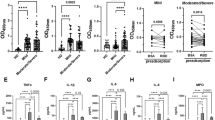Summary
This study determined the levels of serum soluble intercellular adhesion molecule-1 (sICAM-1) and soluble vascular cell adhesion molecular-1 (sVCAM-1) in patients with different types of Keshan disease (KD), examined the relationship between Coxsackie B virus-specific IgM antibody (CBV-IgM) and sICAM-1 or sVCAM-1 in KD patients, and investigated the role of these adhesion molecules in the pathogenesis of KD and their clinical implications. The levels of serum sICAM-1, sVCAM-1 and CBV-IgM were measured by using enzyme-linked immunosorbent assay in 22 patients with chronic Keshan disease (CKD), 27 with latent Keshan disease (LKD) and 28 healthy controls. The subjects in different groups were adjusted for sex and age. Echocardiography was adopted to determine left ventricular ejection fraction (LVEF) in 22 patients with CKD. The results showed that CKD patients had significantly higher levels of sICAM-1 and sVCAM-1 than LKD patients and healthy controls (P<0.01 for all). And there was significant difference in the levels of the 2 adhesion molecules between LKD patients and healthy controls (P<0.05). A negative correlation was found between LVEF and sICAM-1 or sVCAM-1 in CKD patients. The percentage of CBV-specific IgM positive individuals in KD patients was significantly higher than that of healthy controls. In CVB-specific IgM positive patients, the levels of serum sICAM-1 and sVCAM-1 were significantly greater than those in CBV-specific IgM negative counterpart. It was concluded that the increase in the levels of sICAM-1 and sVCAM-1 suggests the progression of inflammation in KD. sICAM-1 and sVCAM-1 can promote the development of myocardial pathology and lead to poor myocardial function. The increased serum sICAM-1 and sVCAM-1 in KD patients may be related to CBV infection.
Similar content being viewed by others
References
Li GS. The effect of Se-deficiency and associated factors on the etiology and etiopathology of Keshan disease. Bull Med Res, 2000,29(4):25–26
Li Y, Peng T, Yang Y, et al. High prevalence of enteroviral genomic sequences in myocardium from cases of endemic cardiomyopathy (Keshan disease) in China. Heart, 2000,83(6):696–701
Beck MA, Kolbeck PC, Rohr LH, et al. Benign human enterovirus becomes virulent in selenium-deficient mice. Med Virol, 1994,43(2):166–170
Wang YP, Niu XL, Zhu JH, et al. The studies of serum IL-6, TNF-α among chronic Keshan disease patients. J Xi’an Med Univ (Eng Edi), 2003,15(1):97–98
Han ZH, Niu XL, Ren FX, et al. Comparison of auto-antibodies against myocardial β1 adrenergic and M2 cholinergic receptors in patients with chronic Keshan disease and dilated cardiomyopathy. Chin J Endemiol (Chinese), 2006, 25(4):440–443
Ulbrich H, Eriksson EE, Lindbom L. Leukocyte and endothelial cell adhesion molecules as targets for therapeutic interventions in inflammatory disease. Trends Pharmacol Sci, 2003,24(12):640–647
Pigott R, Dillon LP, Hemingway IH, et al. Soluble forms of E-selectin, ICAM-1 and VCAM-1 are present in the supernatants of cytokine activated cultured endothelial cells. Biochem Biophys Res Commun, 1992,187(2): 584–589
Ino T, Kishiro M, Okubo M, et al. Late persistent expressions of ICAM-1 and VCAM-1 on myocardial tissue in children with lymphocyticmyocarditis. Cardiovasc Res, 1997,34(2):323–328
Tousoulis D, Homaei H, Ahmed N, et al. Increased plasma adhesion molecule levels in patients with heart failure who have ischemic heart disease and dilated cardiomyopathy. Am Heart J, 2001,141(2):277–280
Xia DY, Yu WH, Ni GZ, et al. Diagnostic standard of Keshan disease. Chin J Endemiol (Chinese), 1997,12(1-A): 63–64
Patrizia A, Marc M, Evelyne C, et al. ICAM-1 and VCAM-1 expression induced by TNF-α are inhibited by a glutathione peroxidase mimic. J Free Radic Biol Med, 1998,24(6):979–987
Yin WH, Chen JW, Jen HL, et al. The prognostic value of circulating soluble cell adhesion molecules in patients with chronic congestive heart failure. Eur J Heart Fail, 2003,5(4):507–516
Quan P, Xu CB, Tan WH, et al. The study of serum CVB-specific IgM antibody and NO among the patients with latent and chronic Keshan disease. J Xi’an Med Univ (Eng Edit), 2001,13(1):5–8
Shen Q, Xu YL, Ling W, et al. Coxsackie B3 virus infection enhances mononuclear cells adhesion to cultured cardiac microvascular endothelial cells. Chin J Immunol (Chinese), 1999,15(7): 302–304
Author information
Authors and Affiliations
Corresponding author
Rights and permissions
About this article
Cite this article
Li, C., Niu, X. & Lei, C. Circulating adhesion molecules in patients with Keshan disease and their relationship with Coxsackie B virus infection. J. Huazhong Univ. Sci. Technol. [Med. Sci.] 29, 173–176 (2009). https://doi.org/10.1007/s11596-009-0207-0
Received:
Published:
Issue Date:
DOI: https://doi.org/10.1007/s11596-009-0207-0



